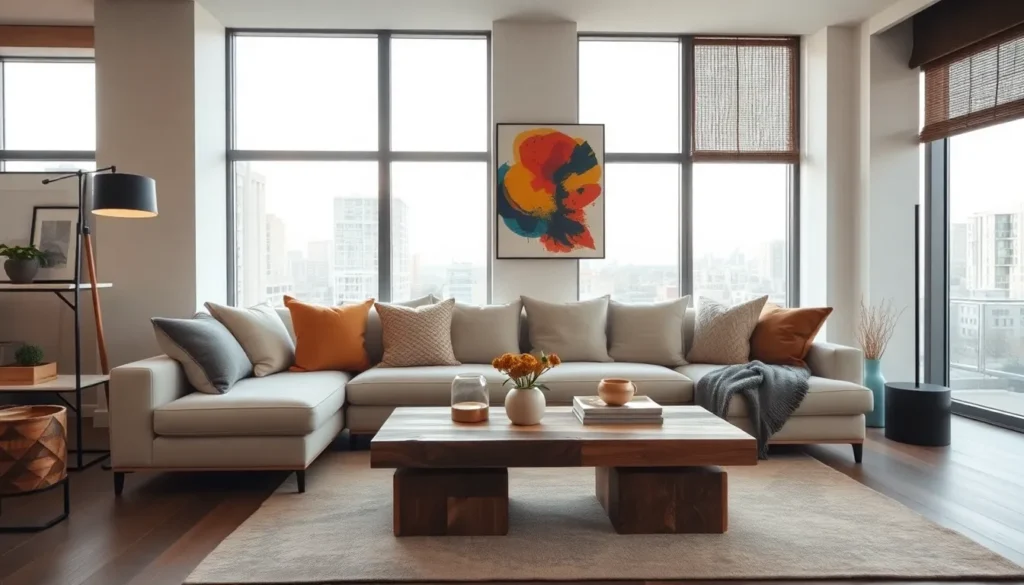Table of Contents
ToggleImagine walking into a space that feels uniquely yours, where every corner tells a story and every detail reflects your personality. Sounds dreamy, doesn’t it? Welcome to the world of design house decor, a realm where creativity meets functionality. It’s not just about throwing a few cushions on the couch and calling it a day. No, my friend, it’s an art form. Whether you’re starting from scratch or looking to spruce things up, understanding the nuances of design house decor can turn a mere house into a home that dazzles. Ready to immerse? Let’s transform your space into the envy of all your friends.
Understanding Design House Decor

Design house decor refers to a cohesive approach to furnishing and styling a living space, focusing on aesthetics while harmonizing functionality. It incorporates various interior design principles tailored to create a specific atmosphere, emphasizing the homeowner’s unique style. The beauty of this concept lies in its versatility. A single style can embrace multiple influences, allowing for an array of captivating looks that still align with the homeowner’s identity.
In this genre, the essence of design isn’t just in the layout but also in how space can be optimized. Understanding the interplay between dimensions, furniture placement, and color palettes is crucial. For example, open-concept spaces require different considerations than traditional, compartmentalized homes. Eventually, it’s about more than just looks: it’s the feeling a space evokes. A well-decorated room is one where you can breathe, relax, and clearly express who you are.
Key Elements of Design House Decor
Every beautiful decor scheme rests on fundamental elements that play together like a well-tuned orchestra. First up is color. Selecting a palette sets the mood, whether soft pastels for tranquility or bold hues for energy. Next, texture comes into play. Mixing textures, like smooth glass with rough wood, adds depth and intrigue to the visual experience.
Another quintessential element is furniture. The choice of pieces influences not only style but also comfort and function. Each item should serve a purpose without cluttering space. Accessories also bear mentioning. From artwork to decorative cushions, these pieces personalize a room and show off the homeowner’s personality.
Finally, let’s not forget about space planning. This aspect determines flow and functionality, ensuring that each area encourages movement and interaction. When all these elements blend seamlessly, they create an inviting environment that guests will appreciate.
Popular Styles in Design House Decor
In the world of design house decor, various styles bloom like flowers in spring. One popular choice is the minimalist style which emphasizes simplicity and order, allowing spaces to breathe. It’s perfect for those seeking a serene atmosphere, devoid of unnecessary distractions.
On the flip side, the bohemian style embraces a more eclectic approach. Layered textiles, vibrant colors, and an assortment of patterns invite character and whimsy into any room. For those who appreciate history, vintage or rustic decor offers a warm embrace of nostalgia with reclaimed materials and antique finds embodying charm.
Then, there’s the contemporary style, where modern functionality meets sleek aesthetics. This design often incorporates technology and sustainable materials, aligning with today’s eco-conscious values. Each style has its allure, catering to varying tastes and lifestyles. Selecting the right style can make all the difference in crafting a home that feels both personal and inviting.
Sourcing Materials and Products
When it comes to sourcing materials for design house decor, the options are virtually limitless. Each piece contributes to the overall narrative of the space. Local artisans often provide unique creations that can’t be found in chain stores, infusing personality into the room. Antique shops and flea markets can yield hidden treasures that add character and richness to the decor.
Shopping online has revolutionized how people find furnishings. Platforms like Etsy or specialized home decor sites offer a range of products, often highlighting sustainable options. Collaborating with local suppliers is another tactic to consider, especially for larger projects. Tapping into the community not only supports local economies but also provides materials with regional flair.
Eventually, the goal is to choose items that resonate with the homeowner’s style while ensuring quality. Investing in well-made pieces often pays off in the long run through durability and sustained aesthetic value.
Tips for Personalizing Your Space
Personalizing a space is where the magic really happens. It’s all about infusing your personality into every nook. One effective method is to incorporate items that reflect personal history, a family heirloom, a piece of art from a memorable trip, or photographs that capture cherished moments. These items breathe life into the decor and invite conversation.
Another great tip is to choose a consistent theme or storyline. For instance, if travel inspires a homeowner, utilizing artifacts collected from different countries can create a cohesive travel-themed decor.
Layering is equally important. Combining different elements like fabrics, colors, and decorative items can add interest and depict various facets of personality, making the space uniquely theirs. Small changes, like swapping out throw pillows or adding plants, can make a significant impact without requiring a full redesign.
The Role of Lighting in Design House Decor
Lighting is often an overlooked hero in the story of design house decor, yet it dramatically affects the ambiance. Different types of lighting evoke varying feelings and can change a room’s dynamics. Think of the difference between harsh overhead fluorescent lights and a warm, inviting table lamp. It’s like night and day.
Incorporating layers of lighting, ambient, task, and accent, ensures versatile functionality and mood setting. Ambient lighting provides general illumination, while task lighting focuses on specific areas such as desks or reading nooks. Accent lighting highlights artwork or architectural details, adding drama and dimension.
Natural light is equally crucial. Well-placed mirrors can reflect sunlight and create an illusion of more space. When designing with light, homeowners should consider the time of day and seasonal changes, tailoring the lighting strategy to enhance comfort and aesthetics.





